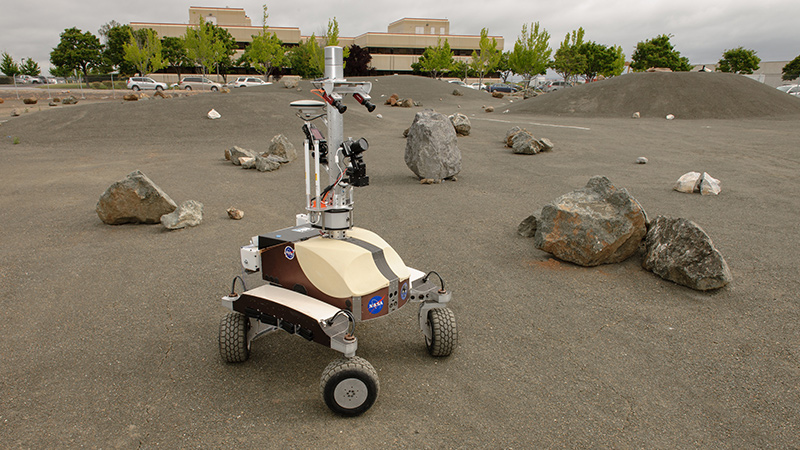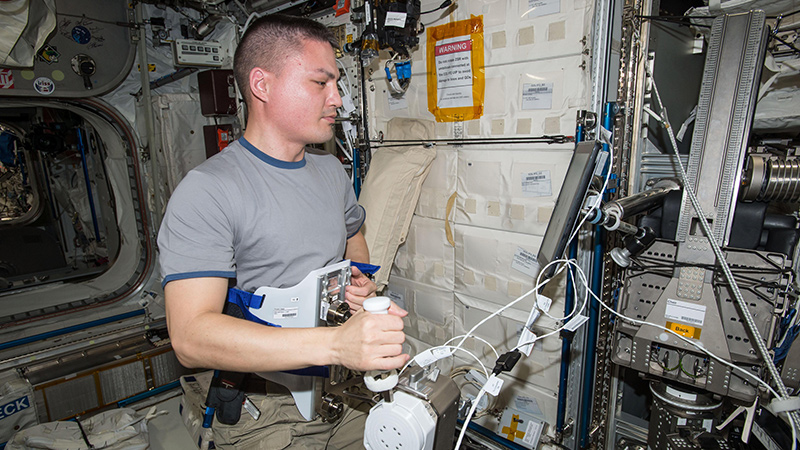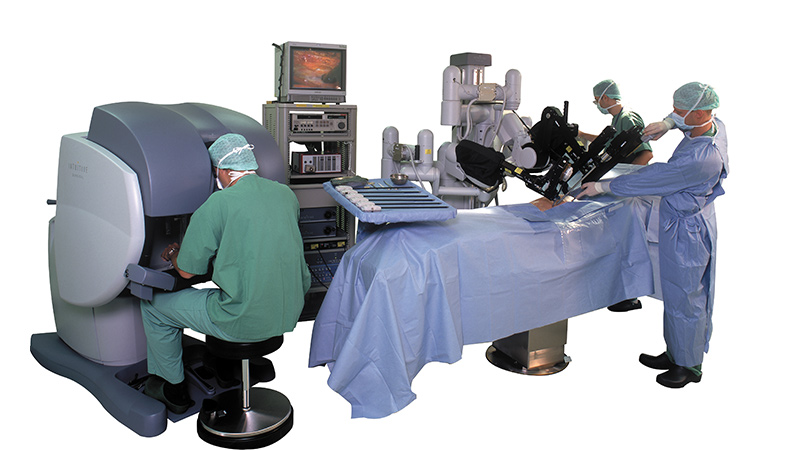Stay Up to Date
Submit your email address to receive the latest industry and Aerospace America news.
Astronauts in Mars orbit could orchestrate complex exploration of the surface
By the mid-2030s, NASA hopes to lead a partnership to land human explorers on Mars, pursuing the search for past or present life. NASA estimates that humans can orbit Mars by the early 2030s, and once established there, land at a date to be determined. But putting humans on Mars is difficult, risky and expensive. Crews would need to ride a multiton lander to the surface using entry, descent and landing technologies that are far from flight-ready. Yet another challenge would be launching astronauts off the surface. Without a major NASA budget increase, astronauts may not set foot on Mars until 2040 or beyond.
A promising technology — exploration telepresence — may help NASA jump-start the intensive human exploration of Mars. Astronauts orbiting Mars in the early 2030s could take real-time control of robotic eyes and hands on the surface, pursuing the search for life in earnest until surface expeditions become reality. They could first test the required technology on the moon or a nearby asteroid.
Editor’s note: In the NASA photo at the top of this page, astronaut Chris Cassidy controls the NASA Ames K10 rover— which is on Earth — from the International Space Station.
Putting human skills on Mars
Even as NASA pursues a Mars landing, our experiences with telepresence on Earth suggest how explorers in Mars orbit and, later, on Mars itself, could be teamed with surface robots to perform complex tasks.
I participated over the past year in a series of workshops hosted by the Keck Institute for Space Studies, examining how today’s telepresence technologies could be advanced and adapted for planetary exploration.
It became clear to me that telepresence is already a terrestrial reality. U.S. Air Force pilots and sensor operators control armed unmanned aircraft half a world away. In the medical field, some operating rooms are equipped with what’s called the da Vinci Surgical System. A surgeon peers into a high-definition video monitor while holding devices that translate his or her hand movements into movements by micro-instruments inserted into the patient’s body a few feet away.
The da Vinci System is an example of virtual presence, also called low-latency telepresence, or LLT, defined as controlling a robot with a communications delay of less than human reaction time (roughly 0.25 second).
Surgeons have near-instantaneous control over their robotic tools, but controlling robots over long distances in space presents latency challenges.
The round-trip radio delay, or latency, to the moon is 2.6 seconds, about 10 times human reaction time. Earth-to-Mars round-trip radio latency is anywhere from five to 40 minutes. From orbit around Mars, astronauts could send signals to and receive them from surface rovers in mere milliseconds, giving them LLT through robotic vision and tactile feedback. With a communications link bandwidth of at least 1 megabit per second (about a third of what it takes to stream standard definition video on our Earthly internet), astronauts could exert real-time control over a rover’s driving and manipulator systems. They could conduct intensive geological and biological field studies for years while NASA perfects its landing and ascent technologies.
Telepresence at Mars
Lockheed Martin last year proposed placing what it calls a Base Camp spacecraft in orbit around Mars as a habitat, logistics and transportation hub for eventual surface expeditions or astronaut excursions to the Martian moons Deimos and Phobos.
In my view, this Base Camp would provide a perfect vantage point for LLT.
While orbiting Mars, or perhaps while dug in on Phobos or Deimos, astronauts could control surface rovers in near-real time, conducting high-intensity field science through their robot proxies. Freed from the lengthy prep time, physical burdens and consumable limitations of a pressure suit, LLT-enabled astronauts could work far more rapidly and productively than rovers like Curiosity or its planned successor, Mars 2020.
NASA equips rovers to drive autonomously just a few tens of meters at a time, taking a day to process images and send up another set of driving or science commands. By contrast, astronauts in Mars orbit would teleoperate a rover and its appendages in near real time for enhanced dexterity and sensory feedback.
Telepresent astronauts could tackle activities beyond the abilities of autonomous systems: drilling into suspected habitable zones, tapping subsurface springs, and traversing steep slopes or entering caves where autonomous rovers would fear to tread.
Astrobiologists in Mars orbit might direct sterilized rovers into regions most likely to harbor life. They could investigate likely habitats for Mars microorganisms, freed from worries that astronaut-borne organisms might muddle the research results.
Astronauts could build the surface infrastructure needed to support human explorers. LLT-directed robots could install power and communications links, activate propellant production plants, and outfit subsurface habitats for astronaut use.
Once astronauts reach the surface, they could begin other LLT operations, including directing scientific rovers around the planet. With “Mars walks” constrained by radiation exposure and suit limitations, telepresence would enable surface geologists and biologists to explore for hours on end in a shirtsleeve environment. When their day’s work is done, Earth-based scientists would pick up operations in autonomous or high-latency mode, as they do today.
Crew benefits
Contemplating a year or more in Mars orbit is a daunting prospect for a crew, but telepresence will enable them to apply their science experience and skills by putting their minds in virtual contact with rovers across Mars. That rich, global exploration experience will counteract the psychological stresses of the long journey as they start the flow of discoveries from human-directed exploration.
Telepresence would also enable crews, perhaps nestled in a buried habitat on Deimos, to avoid some of the harshest features of the Mars environment: radiation, extreme cold, dust storms and toxic soil chemistry.
Low-latency telepresence is a strategy that can be employed on the moon, the nearby asteroids, Mars and other hostile planetary surfaces across the solar system. It breaks the slow, rigid operating mold of rovers run from Earth, accelerating the delivery of high-value science from Mars even as crews prepare for eventual surface exploration.
Perhaps LLT’s most valuable contribution is its clear demonstration of the value of human presence. Once astronauts are fully engaged in exploring Mars via telepresence, what naysayer could turn aside the drive to deliver scientists to the surface in person?
Careful assessment
Will the science volume and quality from orbital telepresence help justify the expense and dangers of sustaining astronauts on successive, multiyear orbital expeditions? Such voyages expose the crew to the health hazards of years of living in free fall, the weightless condition that space travelers would experience during the transit to Mars. These hazards would persist in very low gravity on the Martian moons. The Mars surface offers a possibly safer 0.376-g environment. Should we not just wait a decade for the payoff from the first human landing?
I would argue that if NASA intends to put humans into Mars orbit in the early 2030s, it is important to wring the maximum science value from those costly trips. We should expect returns up front, rather than waiting for surface expeditions. My guess is that telescience will only whet our appetite for the enticing prospect of having scientists on Mars itself.
Planning for telepresence
To achieve LLT access to Mars in 15 years, NASA and its partners should accelerate ground and space trials of telepresence applied to real field science, determining what tasks can be done through supervised autonomy vs. real-time telepresence.
Astronaut-operators on the International Space Station could practice LLT with robots in Antarctic deserts and rugged volcanic landscapes as analogs to Mars.
Future planetary robots should be designed with the vision, mobility, power, communications and manipulator systems to enable virtual presence on the moon, an asteroid surface and ultimately Mars.
Astronauts on the ISS have already controlled terrestrial rovers. Specifically, in 2013, through NASA’s Human Exploration Telerobotics project, ISS astronaut Chris Cassidy controlled a planetary rover at Ames Research Center. Before this year is out, European Space Agency astronaut Paolo Nespoli from the space station will command a complex humanoid robot in a lab as part of continuing tests of the Multi-Purpose End-To-End Robotic Operation Network, or METERON. The next step will be to conduct field exploration trials from the ISS.
Such experience will help NASA design orbital workstations with comfortable 3-D vision, hand or voice-activated manipulator controls, and perhaps tactile feedback from robotic “hands.” NASA is already considering having astronauts in the 2020s remotely drive and manipulate tools on a moon rover from its planned Deep Space Gateway in lunar orbit. Stepping up to true telepresence from lunar orbit would be a logical and worthwhile next step.
The value of humans at Mars
On a shakedown cruise of a Mars orbital vehicle, a crew could explore the dusty, low-gravity surface of a near-Earth asteroid by teleoperating surface hoppers that would cover far more ground at less risk than a suited astronaut could. With lunar and asteroid field experience, crews should then be ready for intensive LLT operations at Mars.
Robotics experts at the Keck Institute workshops were cautious about the promise of artificial intelligence. They thought it unlikely that AI robots will be able to substitute for humans around and on Mars, even two decades from now.
Our species’ curiosity seems unlikely to be satisfied until humans themselves make the long voyage to Mars. The most fundamental questions about Mars biology will likely be answered only once the human mind can fully engage with that alien surface. Low latency telepresence offers the chance to touch that surface sooner rather than later, proving the real value of human explorers in our quest to understand the solar system.
"If NASA intends to put humans into Mars orbit in the early 2030s, it is important to wring the maximum science value from those costly trips."
Tom Jones
About Tom Jones
Tom flew on four space shuttle missions, including his last flight, STS-98, in which he led three spacewalks to install the American Destiny laboratory on the International Space Station. Tom is a senior research scientist at the Florida Institute for Human and Machine Cognition.
Related Posts
Stay Up to Date
Submit your email address to receive the latest industry and Aerospace America news.







